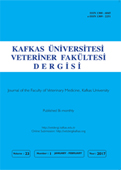
This journal is licensed under a Creative Commons Attribution-NonCommercial 4.0 International License
Kafkas Üniversitesi Veteriner Fakültesi Dergisi
2018 , Vol 24 , Issue 1
Melissopalynological Analysis for Geographical Marking of Kars Honey
1Hacettepe University, Faculty of Science, Department of Biology, TR-06800 Beytepe, Ankara - TURKEY2Hacettepe University Bee and Bee Products Research and Application Center, TR-06800 Beytepe, Ankara - TURKEY
3Bayburt University, Aydıntepe Vocational College, Department of Food Processing, TR-69500 Aydıntepe, Bayburt - TURKEY
4Hacettepe University, Faculty of Pharmacy, Department of Pharmaceutical Botany, TR-06100 Sıhhiye, Ankara - TURKEY DOI : 10.9775/kvfd.2017.18262 In this research, the melissopalynological analysis of honey samples collected from Kars city located in the East Anatolian Region of Turkey was conducted for geographical marking. Within this context, melissopalynological analyses of 100 honey samples determined by sampling method were collected from eight districts of Kars in Eastern Anatolia Region of Turkey were done, to determine the nectarous source plants of Kars honey. As a result of melisopalynological analyses carried out in 100 honey samples; pollens of the taxa belonging to Apiaceae, Asteraceae, Berberidaceae, Betulaceae, Brassicaceae, Boraginaceae, Campanulaceae, Caryophyllaceae, Chenopodiaceae, Cistaceae, Cyperaceae, Dipsacaceae, Ericaceae, Fabaceae, Iridaceae, Lamiaceae, Liliaceae, Malvaceae, Onagraceae, Papaveraceae, Plantaginaceae, Poaceae, Polygonaceae, Ranunculaceae, Rhamnaceae, Rosaceae, Rubiaceae, Rutaceae, Salicaceae and Scrophulariaceae families were detected at different rates. Almost in all of the honey samples, Lotus corniculatus (in 99 samples), Onobrychis radiata (in 99 samples), Trifolium nigrescens (in 88 samples) from Fabaceae family and pollens of Echium vulgaris (81 samples) and Myosotis lithoospermifolia (15 samples) taxa from the Boraginaceae family, were found in honey samples. Onobrychis radiata pollen was the most intensely observed one among these samples (in dominant, secondary, minor, trace amounts). The total number of pollens (TPN-10) in 10 grams of honey were also detected during the melissopalynological analyses. TPN-10 values minimum: 226, maximum: 481157 and mean: 31678 were detected and the pollen abundance of the honeys are classified as good category. Kars is an important province for beekeeping with floral variety. As a result of this study, the first step of the geographical marking studies of Kars" honey was completed. Keywords : Kars, Melissopalynology, Honey, TPN-10










